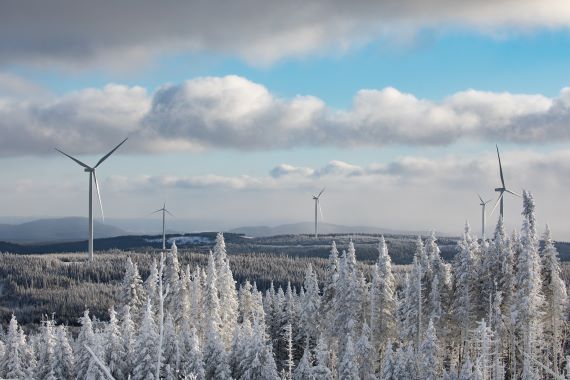The Mesgi’g Ugju’n (MU) wind farm, which produces 150 MW of electricity in Gaspésie, is the result of a partnership between three Mi’gmaq communities and Innergex. (Photo: courtesy of Innergex)
GUEST BLOG. For the first time in a very long time, the economy is suddenly taking Aboriginal vision into account. Our circular view of things is increasingly finding its way into contemporary management methods. Just think of the circular economy and new circular management models. These are traditional views of life cycles or resource use among different aboriginal peoples. We are on a mission to protect our mother earth for at least the next 7 generations.
The Aboriginal economic truth is that we are now present on the stage and at the table with a growing ability to become major players in the economic landscape of Quebec, Canada or the world. Several Aboriginal businesses in Canada are working together to support the growth of the Aboriginal economy from US$32 billion to US$100 billion in the coming years. This is the case with the Indigenomics Institute, the Canadian Council for Aboriginal Business and the First Nations Major Projects Coalition, among others. Through this collaborative work, the Canadian government has introduced a requirement that federal departments and agencies allocate at least 5% of the total contract value to indigenously owned companies. This goal will certainly contribute to the development of a certain economic power.
We are finally regaining the place we once occupied with our successful trade routes. There is an openness to understanding that we want to be responsible for our economic development.
Great achievements and great projects
The economic truth of First Nations in Quebec are also major inter-nation projects with private companies. We are seeing more and more large projects set up with a non-native private company as a partner. Here are three examples that I find interesting to highlight.
Let’s first think of the Mesgi’g Ugju’s’n (MU) wind farm. This 150 MW project, which means “Big Wind” in the Mi’gmaq language, is located in Gaspésie in the MRC d’Avignon. The three Mi’gmaq communities in Quebec have formed a partnership (50-50) with Innergex. It is estimated that spin-offs for the three communities will total nearly US$250 million over 20 years, with direct spin-offs to the MRC d’Avignon contributing US$675,000 annually . As the project is a success, the partners are considering a second phase with the MU2 project.
To stay in the clean energy field, we can also think of the Apuiat wind farm, a 200 MW project born from a partnership between Boralex and Innu. It will be built on the north coast near Port-Cartier and is scheduled to be commissioned in 2024. Its implementation requires investments of nearly $700 million and has created nearly 300 jobs in the region. Another big project.
The metropolis has a spectacular mixed-use real estate project born from a partnership between the Crees (CREECO) and Cogir called Odea Montréal. The building will be located on Robert-Bourrassa Boulevard in western Old Montreal and will contain 435 residential units. Odea Montreal will offer its future residents many common areas and green spaces. In collaboration with the Darling Foundry, the arts are also celebrated. Mathieu Duguay, President and CEO of Cogir Immobilier, said of the project that it would become one of Montreal’s cultural and architectural monuments. Admit it’s exciting.
National Day of Truth and Reconciliation.
September 30 marks National Day of Truth and Reconciliation to commemorate the victims and survivors of boarding schools. This day, recognized by the Canadian government in 2021, is a public holiday only for companies under federal jurisdiction. However, some Quebec companies such as Maison Simons and Quebec Iron Ore have also chosen to declare this holiday in their company.
This national holiday only exists because the truth finally came out in full force when the graves of 215 children were discovered on the site of a former Indian boarding school in Kamloops, British Columbia. The images have gone viral and Canada has been recognized for the treatment it gave to its first residents. Since then, several similarly gruesome discoveries have been made; it is now estimated that several thousand children have died or disappeared in these boarding schools. In short, the truth with a capital V, it must be observed and realized. The last of these boarding schools only closed its doors in 1996. It’s only about fifteen years that separate us from this dark reality. So if this was an open secret, it is now open.
In conclusion, I would be remiss if I did not underline the importance of this economic or corporate reconciliation in higher education. In this sense, the formalization of the presence of First Nations entrepreneurship within the School of Management that “Québec inc. (HEC Montréal) is a big step in the right direction.
—
Since this blog is called Aboriginal Perspective I want to make sure we all have the same definition of the word Aboriginal. In Canada, indigenous peoples include First Nations, Métis, and Inuit. In my text I sometimes refer to Aboriginal people and sometimes to First Nations.

Incurable food practitioner. Tv lover. Award-winning social media maven. Internet guru. Travel aficionado.





;Composite=(type=URL,url=https://images.radio-canada.ca/v1/assets/elements/16x9/outdated-content-2013.png),gravity=SouthEast,placement=Over,location=(0,0),scale=1)

